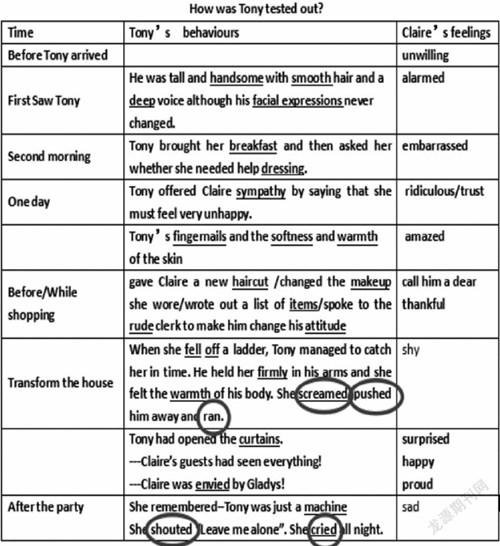基于培养学生思维能力的一节阅读课
谢佳妮

【摘要】 本文以选修七Unit 2: Robots——Satisfaction Guaranteed阅读课第一课时教学设计为例,探讨在阅读教学中如何通过提问的层层深入,逐步提高学生的思维能力。
【关键词】 阅读课 思维能力培养
【中图分类号】 G633.41 【文献标识码】 A 【文章编号】 1992-7711(2019)20-178-020
一、教材分析
这是一篇科幻小说,讲述某公司试验机器人Tony的故事。Tony来到Claire的家,帮助她做家务,为她排忧解难,不仅使她的家变得更有品味,而且帮助她克服心理上的障碍,重塑自身形象。不可思议的是Claire竟对Tony产生了依恋,故事细致入微地描绘了Claire矛盾和恍惚的内心世界,栩栩如生地刻画了Tony某些富于人性的行为细节,这种亦幻亦真的故事情节反映出科幻作品的独特魅力。
二、教学目标
1.在语境中熟练运用本单元的词汇
2.学会抓住故事主线,尤其通过对动作描写的分析,帮助学生更好地体会主人公Claire的情感变化(文章暗线)
3.发展学生的评判性思维和解决問题的创新能力
三、教学过程
Step 1: Lead-in
1.与学生分享最近热播的科幻电影science fiction movie《阿丽塔》,让学生观察图片,然后用英文描述阿丽塔的外貌特征并分享主人公的台词:In the presence of evil, I won’t stand by.(袖手旁观)。
T: Human of robot?
S: A Human being.
smooth hair/facial expressions/a human voice/more like a human than a machine
desire(渴望)to help
【设计意图】:用电影激起学生兴趣;用英文描述外貌特征,自然引出本单元词汇也为后续的写作铺垫了词汇;分享台词是引出本单元词汇desire(渴望)to help和体现主人公面对恶性不袖手旁观的精神,与本课文的机器人Tony为帮助Claire排除万难的精神,和与本单元机器人服务于人类的宗旨是吻合的。
2.T:1)Do you think a robot can think for itself?
have feelings?
2)Do you think it possible for humans and robots to be in love?
【设计意图】:找到影片与课文的共同点:人类爱上机器人,自然引入课文。
Step 2:Reading
1. Introduction of the author and his three laws for robots.
【设计意图】:让学生对小说的作者有基本了解;让学生了解“the First law: A robot must not injure human beings or allow them to be injured.”为后面的问题“Satisfaction Guaranteed?”埋下伏笔。
2.Analyze the genre and elements.
When/ Where/ Who/ What/ Why/ How/ Result
【设计意图】:聚焦小说要素,快速把握文意。
3. Give students 10 minutes to read the passage and 5minutes to fill in the blanks.
【设计意图】:通过表格帮助学生快速把握文章主线(明线:故事情节;暗线:主人公Claire的情感变化),培养学生搜索信息,分析归纳的能力。通过分析动词,让学生更好地揣测主人公的情绪。这些动词推动着情节发展,在Tony要离去时Claire痛苦万分,故事达到高潮。
4.Analyze Tony’s personalities
T:①brought breakfast/ helped dressing/offered sympathy
②spoke to the rude clerk/promised to help/caught…held …/encouraged Claire
③gave…changed…wrote…/transformed her house/opened … on purpose/put on a show
【设计意图】:训练学生分析归纳的能力,只要理解对就行,答案不是唯一的。
Step 3: Post Reading
Critical thinking: Analyze the title and express your opinion about it.
With Tony, whose satisfaction was guaranteed?
possible answers:
to the company (Tony had protected a human being from harm.)
to Claire(Tony helped her regain confidence by making her and her house elegant. But her feeling was hurt.)
to Larry(Both Claire and their house had been improved. However, maybe Larry’s marriage is at risk.)
【设计意图】:本环节的思维培养着力点是批判性思维。思维是由问题引发的,問题设计是高阶思维能力培养的把手和着力点(钟志贤,2004)。在对全文内容有所理解的基础上,对题目进行评判,satisfaction真的guaranteed了吗?
Step 4:Homework
1.写作:(发展学生的解决问题的创新能力。)
With the development of technology, what great conveniences did AI robots bring to us? what great conveniences can AI robots bring to us in the future? Design your future AI robots.
(Remember: The First law is that a robot must not injure human beings or allow them to be injured.)
appearance
functions(what problems can be solved)
Tips:可参考2019年4月9日湛江二中月考题C篇阅读
(文章报道了一项关于人工智能研究领域的新进展——对机器人进行道德培训。当机器人有几种解决问题的途径时,人类可编程奖惩模式让机器人选择合适的那种途径。)
[ 参 考 文 献 ]
[1]教育部.2018.普通高中英语课程标准(2017年版)[M].北京:人民教育出版社.
[2]钟志贤.促进学习者高阶思维发展的教学设计假设[J].电化教育研究,2004(12):25-30.

